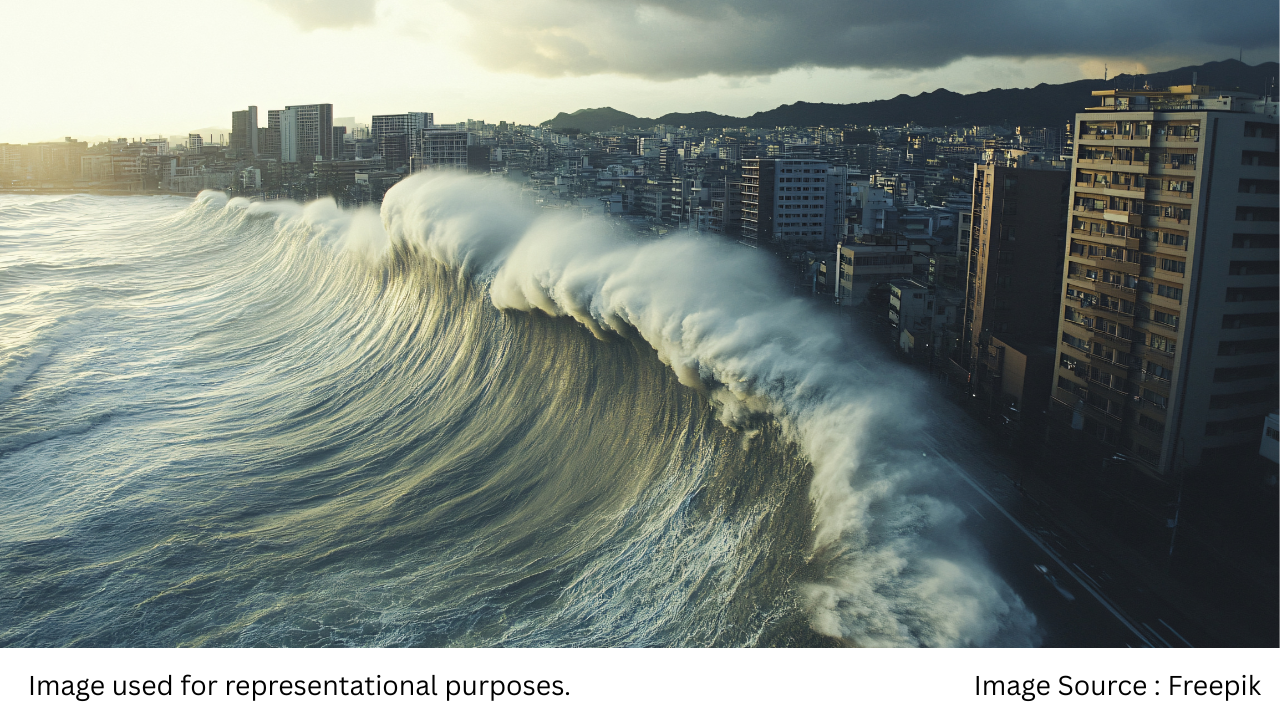
In September 2023, a catastrophic rockslide in a remote Greenland fjord unleashed a natural phenomenon so powerful and mysterious, it echoed around the globe for nine straight days. This wasn’t just another tsunami—it was a mega-tsunami, triggered in Dickson Fjord, where towering cliffs and deep waters created the perfect storm for a disaster that defied all expectations.
While most tsunamis crash and fade within hours, this one refused to die down. It became a rhythmic, global whisper—every 90 seconds—captured by seismic stations from one side of the Earth to the other. Thanks to advanced satellite technology from NASA and France’s CNES, scientists have now pieced together the full story. And what they discovered might be a warning sign about the Arctic’s growing instability in our warming world.
Let’s dive into how this all unfolded.
How the Catastrophic Rockslide Unleashed a Mega-Tsunami in Greenland
On September 16, 2023, an enormous slab of rock gave way from the cliffs above Dickson Fjord in eastern Greenland. The rockslide plunged into the fjord’s waters, generating a powerful tsunami with waves reaching nearly 200 meters (650 feet) in height.
This wasn’t just a momentary disaster. The tsunami energy got trapped within the steep, narrow fjord—causing the wave to ricochet back and forth for nine relentless days. Every bounce sent out a subtle but rhythmic pulse that registered as far as thousands of miles away on seismic instruments. Scientists were baffled: what could cause such a consistent signal for so long?
Cracking the Code: How NASA’s SWOT Satellite Helped Solve the Mystery
The real breakthrough came the very next day.
On September 17, NASA and CNES’s joint mission—the Surface Water and Ocean Topography (SWOT) satellite—flew over the region. This high-tech satellite, equipped with the Ka-band Radar Interferometer (KaRIn), took precise measurements of the water’s surface. What it found was astonishing.
The satellite captured a tilt in the water surface across Dickson Fjord: the north side of the fjord was up to 1.2 meters (about 4 feet) higher than the south side. This revealed a clear, oscillating pattern, proving that the fjord was acting like a giant water-filled bowl—with the wave sloshing from one side to the other in a 90-second cycle.
Josh Willis, a sea-level expert at NASA’s Jet Propulsion Laboratory, commented:
“SWOT happened to fly over at a time when the water had piled up pretty high against the north wall of the fjord… Seeing the shape of the wave—that’s something we could never do before SWOT.”
Why the Tsunami Lasted So Long: The Resonance Chamber Effect
To understand why the tsunami didn’t just fade out like most do, scientists looked at the unique structure of Dickson Fjord itself.
This fjord is a deep, narrow cavity—about 2.7 km (1.7 miles) wide and 540 meters (1,772 feet) deep, with sheer walls that soar more than 6,000 feet (1,830 meters) high. Essentially, it’s a natural acoustic chamber. Once the wave started bouncing within it, there was nowhere for the energy to go. The water just kept rocking back and forth, creating that constant pulse picked up around the world.
In NASA’s words:
“Far from the open ocean, in a confined space, the energy of the tsunami’s motion had limited opportunity to dissipate, so the wave moved back and forth about every 90 seconds for nine days.”
A Rhythmic Global Whisper: The Seismic Signature of the Greenland Tsunami
For over a week, the world’s seismic sensors picked up what they initially couldn’t explain—a monochromatic, rhythmic pulse. Every 90 seconds, the Earth seemed to hum, and no one knew why. It wasn’t until the satellite data was analyzed that the source became clear.
This wasn’t just a regional event. The repetitive tremors were caused by the confined energy of the mega-tsunami within Dickson Fjord. It was like a bell that had been rung once but continued to vibrate—except this bell was made of rock and water, and the sound carried across continents.
Climate Change and the Arctic: A Looming Threat?
While the scientific unraveling of this event is impressive, there’s a darker undercurrent to the discovery. The catastrophic rockslide in Greenland is likely a symptom of the Arctic’s shifting landscape—driven by climate change.
As global temperatures rise, permafrost melts and glaciers retreat. This weakens mountain slopes, increasing the risk of sudden landslides. When those landslides plunge into water, especially in narrow fjords like Dickson, the results can be devastating.
What happened in Greenland may not be a one-off event. It could be a preview of what’s to come if we don’t address the accelerating impacts of climate change in the polar regions.
What Makes This Mega-Tsunami So Unique?
Here’s what sets this event apart from typical tsunamis:
| Feature | Greenland 2023 Tsunami |
|---|---|
| Trigger | Catastrophic rockslide |
| Location | Dickson Fjord, Greenland |
| Wave Height | Nearly 650 feet (200 meters) |
| Duration | 9 days of oscillation |
| Seismic Pulse Cycle | Every 90 seconds |
| Detection Technology | SWOT Satellite, NASA + CNES |
| Unique Impact | Seismic signals recorded worldwide |
This wasn’t a tsunami caused by an earthquake or volcano—it was a slow-moving geological shift that triggered one of the most unique wave events ever recorded.
The Role of Advanced Technology in Disaster Monitoring
One of the most remarkable aspects of this event is how cutting-edge space technology helped solve a complex geophysical puzzle. SWOT’s radar made it possible to visualize water dynamics in a way never done before. It’s a powerful reminder of how satellites can provide critical insights into natural disasters—even those happening in Earth’s most remote corners.
As we continue to invest in Earth observation technologies, we increase our ability to respond to disasters, warn communities, and understand climate-related changes in real time.
My Opinion: Why We Should Be Paying Attention
This event should be a wake-up call.
Not just because of how rare and powerful the Greenland tsunami was, but because it reveals how connected everything is—from a rockslide in a remote Arctic fjord to seismic pulses felt across the globe.
The fact that such a large and long-lasting tsunami can be triggered by climate-accelerated geological shifts is alarming. The Arctic is becoming less stable, and the consequences could ripple far beyond Greenland’s icy cliffs.
It’s not just about understanding what happened. It’s about preparing for what might come next.
Conclusion: Lessons from a Mega-Tsunami
The 2023 mega-tsunami in Greenland is more than a scientific curiosity. It’s a vivid example of how our planet can surprise us—and how human technology and curiosity can help us understand it. The catastrophic rockslide in a remote Greenland fjord didn’t just trigger a wave; it triggered a global story of resilience, resonance, and realization.
As the Arctic warms and the Earth shifts, events like this might become more common. Thanks to tools like the SWOT satellite, we now have the ability to track and learn from them in ways we never could before.
And that knowledge may be our best defense.
Aamir Ahmad Fateh is a seasoned digital marketer and experienced news writer with over 7 years of expertise in covering political affairs, social issues, technology, sports, and Bollywood. He is the founder and chief editor of 24fnews.com, where he is dedicated to delivering accurate, unbiased, and timely news to a wide audience every day. His sharp insights and journalistic integrity make him a trusted voice in the digital news space.



